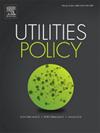加纳碳排放与电价之间的动态关系
IF 4.4
3区 经济学
Q3 ENERGY & FUELS
引用次数: 0
摘要
在碳排放和电价之间建立明确的关系对于制定有效的能源和环境政策至关重要。在加纳,电价是使用回报率方法确定的,其重点是确保电力供应商能够收回成本并实现合理的投资回报。然而,这种方法目前将碳排放作为一个变量排除在外,导致关税可能无法反映与发电碳排放相关的环境成本。该研究调查了加纳发电产生的碳排放与电价之间的关系。使用1985年至2021年的年度时间序列数据。本研究采用自回归分布滞后(ARDL)(界限检验)方法建立变量之间的短期和长期关系。根据ARDL的结果,碳排放对关税的长期和短期影响都是积极的。然而,从长远来看,碳排放量大幅减少,反映了电价的下降。研究结果表明,从长远来看,该国碳排放量每增加1%,电价就会上涨约0.0153%。然而,在5%的显著性水平下,短期内碳排放量的相应增加与电价的等效增加0.025%相关。总之,将碳排放纳入电价制定过程对于制定加纳可持续和对环境负责的能源政策至关重要。通过在碳排放和电价之间建立明确的相关性,政策制定者可以更好地将经济激励与环境目标结合起来。鼓励为可再生能源投资创造有利的环境,将有助于减少碳排放,并支持电价的长期下降,与全球趋向于更清洁、更可持续的能源解决方案保持一致。本文章由计算机程序翻译,如有差异,请以英文原文为准。
The dynamic relationship between carbon emissions and electricity tariffs in Ghana
Establishing a clear relationship between carbon emissions and electricity tariffs is crucial for developing effective energy and environmental policies. In Ghana, electricity tariffs are determined using the rate of return methodology, which focuses on ensuring that electricity providers can recover costs and achieve a reasonable return on investment. However, this methodology currently excludes carbon emissions as a variable, resulting in tariffs that may not reflect the environmental costs associated with carbon emissions from electricity generation. The study investigated the relationship between carbon emissions generated from electricity generation and electricity tariffs in Ghana. Annual time series data from 1985 to 2021 were used. The research used the Autoregressive Distribution Lag (ARDL) (bounds test) methodology to establish the short-term and long-term relationships among variables. Based on the ARDL results, carbon emissions impacted tariffs positively in the long and short run. However, carbon emissions were reduced drastically in the long run, reflecting a decline in electricity tariffs. The study's findings indicate that, in the long run, a 1 % rise in the country's carbon emissions is directly associated with an increase in electricity tariffs of about 0.0153 %. However, a proportionate increase in carbon emissions in the short run is associated with an equivalent increase in electricity tariffs by 0.025 % at a 5 % significance level.
In conclusion, integrating carbon emissions into the electricity tariff-setting process is vital for creating Ghana's sustainable and environmentally responsible energy policy. By establishing a clear correlation between carbon emissions and electricity tariffs, policymakers can better align economic incentives with environmental goals. Encouragement of a favorable environment for renewable energy investments will contribute to reducing carbon emissions and support the long-term decline in electricity tariffs, aligning with global trends toward cleaner and more sustainable energy solutions.
求助全文
通过发布文献求助,成功后即可免费获取论文全文。
去求助
来源期刊

Utilities Policy
ENERGY & FUELS-ENVIRONMENTAL SCIENCES
CiteScore
6.80
自引率
10.00%
发文量
94
审稿时长
66 days
期刊介绍:
Utilities Policy is deliberately international, interdisciplinary, and intersectoral. Articles address utility trends and issues in both developed and developing economies. Authors and reviewers come from various disciplines, including economics, political science, sociology, law, finance, accounting, management, and engineering. Areas of focus include the utility and network industries providing essential electricity, natural gas, water and wastewater, solid waste, communications, broadband, postal, and public transportation services.
Utilities Policy invites submissions that apply various quantitative and qualitative methods. Contributions are welcome from both established and emerging scholars as well as accomplished practitioners. Interdisciplinary, comparative, and applied works are encouraged. Submissions to the journal should have a clear focus on governance, performance, and/or analysis of public utilities with an aim toward informing the policymaking process and providing recommendations as appropriate. Relevant topics and issues include but are not limited to industry structures and ownership, market design and dynamics, economic development, resource planning, system modeling, accounting and finance, infrastructure investment, supply and demand efficiency, strategic management and productivity, network operations and integration, supply chains, adaptation and flexibility, service-quality standards, benchmarking and metrics, benefit-cost analysis, behavior and incentives, pricing and demand response, economic and environmental regulation, regulatory performance and impact, restructuring and deregulation, and policy institutions.
 求助内容:
求助内容: 应助结果提醒方式:
应助结果提醒方式:


